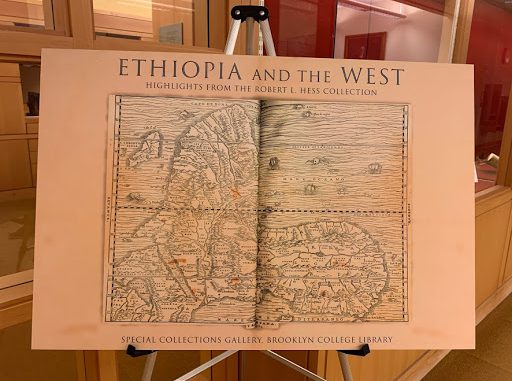
Robert L. Hess Collection Offers Students Research Treasure Trove
The history of the Horn of Africa has come to Brooklyn College in a new exhibit on display in the library. Ethiopia and the West: Highlights from the Robert L. Hess Collection, features manuscripts and artifacts which are located in front of the archives section. Former president of Brooklyn College, and a noted specialist in Somalia and Ethiopia studies, Robert L. Hess’ book and artifact collection were donated to the Brooklyn College Archives by his widow, Frances Hess. The Hess family also gifted the archives of Brooklyn College with an annual endowment, which was used to purchase manuscripts and photographic collections that fit the themes of the Hess Collection.
The period of East African history which this collection works from, dates to the early 20th century– a turbulent time for the region. Italy had colonized Ethiopia, exiled the Emperor and his royal family, and began to take resources from Ethiopians and Somalians. An estimated 16,000 Ethiopians were killed during the Italian invasion. The Hess collection contains manuscripts and other materials which offer insight into these events.
The exhibit focuses on Ethiopia’s role in world history as well as the relationship between Europe and the Horn of Africa. The history that is explored in the exhibit includes the betrayal of Ethiopia by the League of Nations and the colonization of Ethiopia by Italy from 1935 to 1941. During this time, the League of Nations was established after World War 1 in order to prevent another world war. Italy, which was invading Ethiopia, was ruled against by the League. The League voted to place economic sanctions on the nation, however, they never followed through. Italy simply quit the league and continued to colonize Ethiopia mostly without any international interference.
Professor Colleen Bradley Sanders hopes that one of the results of the exhibit is “to get people more interested in using the [Hess] collection, and to know what we [the archives] have.” Certainly, for the average student, the archives section in the library hasn’t been proven itself useful. However, as the Hess exhibit shows, the archives offers an incredible selection in primary sources available for students to use for research. In the exhibit alone, there are journals and diaries from Italian officers from the occupation, preserved manuscripts from Ethiopia in Amharic and Ge’ez (Native Ethiopian languages), 17th century “studies” on Ethiopia in German, along with many others from all over the world.
Even for students who are not currently doing research on the Abyssinian Empire, Italian colonialism, or the modern history of Ethiopia they can still enjoy the display and learn a great deal of history from it. One of the photo collections on display is from an Italian officer who married an Ethiopian woman during his stay in the country. The photo collection features pictures that he took and drawings by his wife.
While many of the texts are very informative and factual– there is a deep underlying human element to all of them. The suffering endured by the people of Ethiopia and Somalia as a result of colonialism is unmistakable. In a booklet entitled Why was the Lion of Judah Defeated? by Ras Bitwäddäd, who was a noble and companion of Emperor Haile Selassie, a beloved African leader who spoke out against colonialism during World War II, Bitwäddäd records the “plight of the royal family, and a detailed list of notable exiles,”as noted in the exhibit. This history cannot be understated or ignored, so if you have a spare moment while passing through the library– spend it exploring this new addition to the library’s displays.
